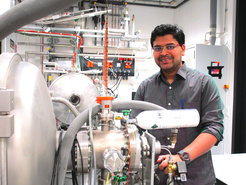Artificial Comets in the Lab
This year’s Dieter-Rampacher-Prize goes to cometary scientist Dr. Chaitanya Giri from the Max Planck Institute for Solar System Research.
The Max Planck Society has awarded Dr. Chaitanya Giri from the Max Planck Institute for Solar System Research (MPS) this year’s Dieter-Rampacher-Prize. With this award, the Max Planck Society annually honors the youngest Max Planck scientist who successfully completed his or her PhD-thesis during the past year. In his thesis, which has been submitted to the University of Nizza, Giri tracks down the organic compounds in cometary material. Could these building blocks of life have travelled to Earth on board of comets? And which substances are responsible for a comet’s deep black color? The Dieter-Rampacher-Prize was awarded today in Berlin during the General Assembly of the Max Planck Society.

Dr. Chaitanya Giri’s research objects orbit the Sun many millions of kilometers away from Earth. Comets spend the greater part of their life in the depth of space; only occasionally do they advance into the inner Solar System. But even though they are practically inaccessible, Giri studies these distant bodies from up close – within the laboratory. “For our experiments we try to artificially engineer components of comets”, the 27 year old scientist explains. “We can then study what properties this material has and how it has developed since its origin.”
Apart from frozen gases such as water and rocks, comets most liekly also contain complex organic compounds such as amino acids, the building blocks of proteins. Scientists deem it possible, that impacts of comets supplied the young Earth with these compounds. A key to testing this hypothesis is the inner architecture of amino acids. An amino acid can exist in one of two possible versions. Both contain exactly the same atoms, but are the exact mirror image of the other. “Astonishingly, on Earth almost all amino acids occur in just one of these architectures”, says Giri. Is this asymmetry a legacy of their cometary past?
Until recently there was no possibility to identify the architecture of cometary aminoacids. In order to address this issue nevertheless, Giri traveled to the SOLEIL synchrotron in Paris. There he irradiated a mixture consisting in equal parts of both versions of the amino acid alanine with circularly polarized light. “This type of radiation occurs in the interstellar nebular at the outer rim of our Solar System where we believe that comets originated. We wanted to find out, if it is able to change cometary material containing both types of amino acids”, explains Prof. Dr. Uwe Meierhenrich from the University of Nizza who supervised Giri’s research.
Indeed, this seems to possible. Depending on the polarization and energy of the light, the fraction of one of the two versions in the mixture can increase. “It is conceivable, that this asymmetry originated in the interstellar nebular and then propagated to the inner Solar System by means of comets”, says Giri.
Organic compounds may also be responsible for a comet’s black color. In further experiments Giri studied tholin, a solid material that can be generated from gaseous nitrogen and methane. These substances were also present in the comets hour of birth. Giris research shows that apart from several other complex carbon molecules tholin also contains graphite. “This could be the substance that paints cometary surfaces black”, says Giri.

„Experiments of this kind demonstrate possibilities”, the chemist adds. “We can only achieve certainty with the help of real cometary material.” Luckily, this material is not entirely unattainable. On 12 November, 2014 Rosetta’s lander Philae gently touched down on the surface of comet 67P/Churyumov-Gerasimenko. On board it carries the COSAC instrument which was developed and built at the MPS in order to analyze organic molecules in cometary material. Before the landing, Giri simulated possible results of these measurements with the help of the flight spare model of COSAC, an exact twin of the flight model stationed at MPS.
„These preliminary studies are now extremely valuable to us“, says COSAC Principal Investigator Dr. Fred Goesmann from the MPS. Data from the first scientific measurements on the comet’s surface are now available. MPS researchers are currently interpreting it. In addition, the scientists hope to conduct new measurements soon. The Philae lander woke up from its seven month hibernation last weekend and is thought to continue its scientific mission soon.
Chaitanya Giri studied Chemistry and Biophysics at the University of Mumbai in India. At the age of 23 he commenced is doctoral studies at the University of Nizza and the MPS. He completed these in September 2014 at the age of 26. Here is therewith the youngest Max Planck PhD-student to finish his thesis in 2014.

